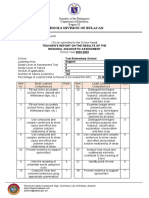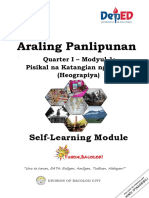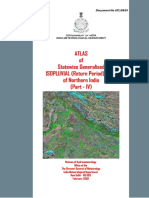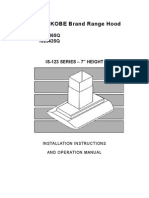Second Quarter Exam
Second Quarter Exam
Uploaded by
Jan Bryan EslavaCopyright:
Available Formats
Second Quarter Exam
Second Quarter Exam
Uploaded by
Jan Bryan EslavaCopyright
Available Formats
Share this document
Did you find this document useful?
Is this content inappropriate?
Copyright:
Available Formats
Second Quarter Exam
Second Quarter Exam
Uploaded by
Jan Bryan EslavaCopyright:
Available Formats
Republic of the Philippines
Department of Education
REGION I
PANGASINAN SCHOOLS DIVISION OFFICE II
MANGALDAN NATIONAL HIGH SCHOOL
MANGALDAN, PANGASINAN
AUTOMOTIVE SERVICING
FIRST QUARTER EXAM
SY 2022-2023
Part I. Multiple choice
Directions: Read and understand the following statements and choose the best answer. Write your answer on a sheet of
paper and use blue/black ballpoint only.
Multiple Choice: Select the best answer that corresponds to the statement.
1. Diesel engine combustion is the process of combusting _______________ to create an expanding gas that makes the
engine operate.
a. water and oil b. air and water c. fuel d. fuel and air
2. What is the correct order of the 4 strokes of an internal combustion engine?
a. Compression, Intake, Exhaust, Power c. Intake, Power, Compression, Exhaust
b. Power, Compression, Intake, Exhaust d. Intake, Compression, Power, Exhaust
3. The Engine revolutions per minute (RPM) measures the rotations of what component?
a. Camshaft b. Crankshaft c. Starter d. Connecting rods
4. What is the minimum number of cylinders required for a 4 stroke engine to ensure no interruptions in output power?
1. 5 2. 3 3. 1 4. 4
5. Fuel injection permits higher compression ratios because?
a. the cylinder size is variable. c. the strokxe can be extended.
b. air can be compressed before d. fuel is mixed with air before
fuel is added. compression.
6. Diesel engines offer better fuel economy and more power under heavy loads than gasoline engines because the
_____________ can be changed to fit the load.
a. fuel to air ratio b. oil to fuel ratio c. air flow d. air to core ratio
7. What does a fuel injector do?
a. inject fuel
b. set and control fuel pressure to the rail
c. control the timing and the atomization (spray) of fuel delivery into the cylinder
d. control fuel flow from the tank, through the filters, to the engine
8. Diesel engines operate within set speed limits. The bottom limit is called ______ and the upper limit is called _____.
a. bottom speed, top speed c. low limit, high limit
b. low speed, high speed d. low idle, high idle
9. Engine speed will drop as more power is needed. To produce more power and raise engine speed again, more fuel
must be supplied. This control system function is done automatically by a ______________.
a. governor b. fuel valve c. fuel pump d. fuel injector
10. Why is fuel filtration important to diesel engine operation?
a. Fuel can mix with oil and must be separated by a filter.
b. Dirty fuel can plug and damage the fuel injectors. Plugged injectors will not deliver the correct amount of
fuel.
c. The fuel contains too much oil as delivered.
d. Fuel filters are not important. Diesel fuel will burn the same way regardless of contamination.
11. Why does a Caterpillar diesel engine require a cooling system?
a. Cylinder combustion temperatures are really high (fuel is exploding!).
b. The sun can make the engine very hot on a hot day.
c. Engines do not need cooling system. Air circulation cooling is sufficient.
d. Fuel will spontaneously combust if the engine is not cooled.
12. The intake air compressor of a turbocharger is turned by what component?
a. the timing gear b. the exhaust turbine c. the water pump flow d. the crankshaft
13. Diesel engines offer better fuel economy and more power under heavy loads than gasoline engines because the
_____________ can be changed to fit the load.
a. fuel to air ratio b. oil to fuel ratio c. air flow d. air to core ratio
14. Diesel engine combustion is the process of combusting _______________ to create an expanding gas that makes the
engine operate.
a. water and oil b. air and water c. fuel d. fuel and air
15. Diesel engines operate within set speed limits. The bottom limit is called _______ and the upper limit is called _____.
a. bottom speed, top speed c. low limit, high limit
b. low speed, high speed d. low idle, high idle
Part II. True or False
Direction: Write the word true if the standard is correct and false if it is wrong.
_________1. Metering and proportioning valves balance the braking characteristics of disc and drum brakes. True
_________2. The name duo-servo drum brake is derived from the fact that the self-energizing force is transferred from
one shoe to another with the wheel rotating forward. True
_________3. Disc brakes are not as likely to fade during heavy braking as are drum brakes. false
_________4. True or False? All calipers have at least one piston that pushes the brake pad against the rotor? true
_________5. Lower steering efforts are desirable at highway speeds in order to provide improved road fell.
_________6. Tire wear patterns are good indicators of steering and suspension problems.
_________7. Power steering fluid pressure can be measured with a scan tool.
_________8. True or False. The faster a shock absorber moves, the more resistance it has to the movement.
_________9. The faster a shock absorber moves, the more resistance it has to the movement.
_________10. A vehicle will pull to the side with the most (positive) toe.
Part III. Multiple Choice
Directions: Choose the correct answer of the following questions from the choices given. Write the letter that corresponds
to your answer on the blank provided.
16. The space, allowance or gap between working parts of an engine, which sometimes is occupied by oil.
a. Clearance c. Gap
b. Spacer
17. Act or instance of burning
a. Exhaust c. Compression
b. Intake d. Combustion
18. It measures the electrical resistance
a. Volt meter c. Ohmmeter
b. Tachometer
19. Measuring gap for spark plug
a. Feeler gauge c. Plastiguage
b. Wire gauge d. Ruler
20. Can take both inside and outside measurements.
a. Vernier caliper c. Voltmeter
b. Micrometer d. Dial gauge
21. What is used to engage & disengage the gear/s of the transmission?
a. brake c. mirror
b. clutch
22. What are the three uses of clutch?
a. stepping, stopping, shifting c. starting, stopping, shifting
b. braking, stepping, shifting
23. What kind of break is used for emergency stopping or parking
a. foot brake c. gas brake
b. hand brake
24. What does half-braking means?
a. making the brake bite c. slowing
b. stopping completely
25. What foot should be properly stopped on the pedal for the clutch?
a. left c. left and right
b. right
26. What is the alternative means to use if the light signals are not functioning?
a. horn c. hand
b. pedal
27. What mirror is used to glance at the back for the car to check if you are free to overtake & when driving backward,
garage parking and backing?
a. left side mirror c. rearview mirror
b. right side mirror
28. How will you execute the hand signal if you will be going to make a left turn?
a. the left hand points upward outside the vehicle
b. the left hand points downward outside the vehicle
c. extending the left hand straight (sideways) outside the vehicle
29. Where can you usually see the “no blowing of horns signs?
a. hospital & churches only c. All of the above.
b. schools only
30. What is used mainly for increasing & decreasing the speed of the car?
a. clutch pedal c. gas pedal
b. brake pedal
31. Unlike internal combustion engines, external combustion engines require a --
a. Cylinder c. Boiler
b. Piston
32. Engines transform heat energy to--
a. Electricity c. Kinetic energy
b. Mechanical energy
33. In an internal combustion engine, burning fuel within an enclosed cylinder results in the expansion of gases. This
expansion creates pressure that --
a. Heats the boiler c. Moves the piston downward
b. Spins the flywheel
34. When volume inside the cylinder decreases, pressure --
a. Increases
b. Stays the same
c. Decreases
35. As pressure increases inside the cylinder, temperature --
a. Decreases c. Increases
b. Stays the same
36. When the piston moves up and down, it is called --
A. Repeating motion D. Reciprocating motion moves in random
B. Resetting motion directions
C. Reciprocating motion E. straight line
37. To turn the wheels of a vehicle, reciprocating motion must be turned into ---
A. Kinetic energy C. Rotary motion
B. Torque
38. Reciprocating motion is changed to rotary motion through use of a ---
A. Cable C. Fuel line
B. Crankshaft and connecting rod
39. For every two rotation of 2-strokes engine, the crankshaft ---
A. Makes one complete revolution C. Remains stationery
B. Makes a half-turn
40. The position of the piston at the instant its motion changes from down to up is known as ---
A. Exact half-way point C. Bottom dead center
B. Top dead center
41. The position of the piston at the instant its motion changes from up to down is known as ---
A. Bottom dead center C. Exact half-way point
B. Top dead center
42. How many comprise action taken by four-stroke cycle engine?
A. Four C. Two
B. Three
43. During the intake stroke, the intake valve is ---
A. Partially open C. Open
B. Closed
44. When the piston moves downward inside the cylinder, it produces ---
A. Large amounts of heat C. Noise
B. A partial vacuum
45. At what point during the compression stroke does the intake valve close?
A. When the crankshaft rotates
B. When the piston reaches TDC
C. When the piston reaches BDC
46. Ignition takes place as the piston reaches ---
A. DOA C. TDC
B. BDC
47. The burning fuel inside a cylinder causes pressure to rise to ---
A. Between 600 - 700 pounds per square inch
B. Between 600 - 700 tons per square inch
C. Between 600 - 700 pounds per centimeter
48. When does the exhaust valve open?
A. When the exhaust fumes reach a certain point
B. After the piston stops moving
C. Just as the power stroke is finished
49. The four events in a two-stroke-cycle engine are:
A. Compression, power, intake, exhaust
B. Intake, power, compression, exhaust
C. Intake, compression, power, exhaust
50. How many events does a diesel engine have to complete one cycle of operation?
A. Six C. Three
B. Eight D. four
51. How many power strokes are produce by one revolution of the crankshaft in a two-stroke-cycle engine?
A. Four C. One
B. Two
52. Does a two-stroke-cycle engine produce more power than a four-stroke-cycle engine?
A. Yes C. Maybe
B. No
53. A two-stroke-cycle engine produces less power per stroke than a four-stroke-cycle engine because it has less ---
A. Air C. Volume
B. Fuel
54. What does the two-stroke-cycle engine require that the four-stroke-cycle engine do not?
A. Exhaust valve
B. Boiler
C. Blower
55. A low-mileage vehicle is running hot. Assuming the radiator has enough coolant, what is the most likely problem?
a. The block has a partial restriction.
b. The water pump has broken down.
c. The thermostat has stopped working.
d. All of the above
e. Either b or c
56. A car is pulling to one side as it drives. The most common causes of this problem are listed below. Which one should
you check first?
a. Uneven tire wear c. Low or uneven tire pressure
b. Bad alignment d. A sticking brake caliper
57. You are replacing a fuel tank. You've drained and stored all the gas in the vehicle. What is the next step?
a. Take the straps off the tank and drop it. c. Drop the rear suspension
b. Disconnect the fuel lines. d. None of the above
58. An engine is misfiring. Which of the following is NOT a likely cause?
a. The ignition timing may be set wrong.
b. The cooling system may be malfunctioning.
c. The fuel filter may be clogged.
d. The vehicle may have a vacuum leak.
42. An engine has recently begun using a lot of oil and the coolant is foamy and brown. Which of the following is likely
to have caused this problem?
a. A cylinder head has been cracked. c. The oil-to-water cooler is leaking.
b. A head gasket has blown. d. Any of the above
59. Vehicle is having difficulty with steering. Which of the following is the most likely cause?
a. The power steering belt needs to be adjusted or c. The power steering pump needs to be replaced.
replaced.
b. The vehicle is low on power steering fluid. d. The power steering rack is leaking.
60. Which of the following is NOT a common reason the CHECK ENGINE light comes on in most vehicles?
a. The battery is dying. c. The spark plug wires need to be replaced.
b. The gas cap is loose.
d. The engine has somehow gotten wet.
61. A brake pedal has no or little air pressure. Which of the following is not likely to be the cause?
a. A bad master cylinder c. Vacuum problems
b. Air in the brake fluid d. Low brake fluid
62. If you find anything unsafe during the pre-trip inspection, you are required to:
a. Inform your motor carrier after the trip. c. Drive cautiously until it is fixed.
b. Get it fixed before driving. d. Write it in your inspection report.
63. Name some exhaust system parts.
a. Pitman arm, hydraulic fluid reservoir and tie rod
b. Mufflers, mounting brackets and catalytic converter
c. Drag link, spindle and gear box
d. Main spring, axle and font axle hanger
64. What should be clean with no obstructions, illegal stickers, or damages to the glass?
a. The lighting indicators. c. The windshield.
b. The headlights. d. None of the above.
65. During the vehicle inspection, when approaching the vehicle you should:
a. Check that the vehicle is parked properly.
b. Look under the vehicle for fresh oil, fuel leaks or coolant.
c. Check that the vehicle is clear.
d. Check that the parking brakes are not set.
66. When taking the road test, if asked to make a turn you should:
a. Check for traffic in all directions. c. Slow down before making the turn.
b. Use turn signals. d. All of the above.
67. What should you do to test your hydraulic brakes for leaks?
a. Pump the brake pedal three times, then apply pressure for 9 seconds.
b. Hold the brake pedal down for five seconds, then pump it three times.
c. Pump the brake pedal five times, then apply pressure for three seconds.
d. Pump the brake pedal three times, then apply pressure to the pedal and hold for five seconds.
68. Which of the following is NOT part of a standard vehicle inspection?
a. Seating defects. c. Wheel and rim problems.
b. Tire problems. d. Bad brake drums or shoes.
69. What does the crankshaft do?
a. Nothing - it is not part of an engine
b. Actuate the valves to fill air and vent exhaust to the cylinder
5|7
c. Translate reciprocating motion from the piston to rotary motion
d. Meter and inject fuel to control combustion
70. Diesel engine combustion is the process of combusting _______________ to create an expanding gas that makes the
engine operate.
e. water and oil g. fuel
f. air and water h. fuel and air
71. The flywheel is a heavy weight attached to the crankshaft that?
a. Controls the timing to open and close the intake and exhaust valves.
b. Stores and releases kinetic energy during the intake, compression, and exhaust strokes.
c. Is super fly and shaped like a pizza.
d. Stores and releases rotational energy to start the engine.
72. Each movement of the piston in and out of the cylinder is called a
a. Compression. c. Stroke.
b. Exhaust. d. Shift.
73. What is the correct order of the 4 strokes of an internal combustion engine?
a. Compression, Intake, Exhaust, Power c. Intake, Power, Compression, Exhaust
b. Power, Compression, Intake, Exhaust d. Intake, Compression, Power, Exhaust
74. Engine revolutions per minute (RPM) measure the rotations of what component?
a. Camshaft c. Starter
b. Crankshaft d. Connecting rods
75. The diameter of the engine cylinder is called the ______ and the distance the piston can move is called the ________.
The multiplication of these 2 factors provides the engine __________.
a. bore, stroke, displacement c. bore, cam ratio, displacement
b. displacement, stroke, bore d. cat, dog, unicorn
76. Diesel engines offer better fuel economy and more power under heavy loads than gasoline engines because the
_____________ can be changed to fit the load.
e. fuel to air ratio g. air flow
f. oil to fuel ratio h. air to core ratio
77. What does a fuel injector do?
a. Inject fuel.
b. set and control fuel pressure to the rail
c. control the timing and the atomization (spray) of fuel delivery into the cylinder
d. control fuel flow from the tank, through the filters, to the engine
78. Diesel engines operate within set speed limits. The bottom limit is called ____________ and the upper limit is called
_____________.
e. bottom speed, top speed g. low limit, high limit
f. low speed, high speed h. low idle, high idle
79. A shaft in the engine, which has a series of cams for operating the valve mechanism.
a. Crankshaft b. Input shaft c. Camshaft
Part IV. Matching Type
Directions: Match the function of the Measuring tool in Column A with its name in Column B. Write the letter of your
choice before the number.
Column A ________14. A hand held
________1. It measures the electrical resistance precision measuring
________2. Used in setting a perfect timing for the spark plug to give instrument
electric spark during combustion in the ignition system ________15. Can take both
________3. A device for measuring engine speed or revolution per minute inside and outside
________4. Used to measure the specific gravity of battery electrolyte to measurements
determine the state of battery charge Column B
________5. A device for measuring the potential difference of voltages A. Ohmmeter
between two points such as the terminals of battery alternator or two B. Dial indicator
points in an electric circuit
________6. Used for diagnosing ignition and other electrical problems C. Tachometer
________7. Used to test the compression pressure of the individual D. Timing light
cylinders, E. Hydrometer
________8. Used to track down troubles in an engine that does not run as F. Voltmeter
well as it should
G. Compression tester
________9. A plastic material available in strips of various diameter
________10. Are strips and blades of metal of various thicknesses? H. Oscilloscope
________11. It has a dial face and a needle to register measurements I. Feeler gauge
________12. This are precisely sized pieces of round wire J. Steel rule
________13. The simplest tool used for measuring linear distances K. Vacuum gauge
6|7
L. Micrometer
M. Plastigage
N. Vernier caliper
O. Wire gauge
7|7
You might also like
- Napapahalagahan Ang Kahalagahan NG Pangangalaga Sa Timbang Na Kalagayan Ekolohiko NG Reliheyon. (AP7HAS-Ig-1-7)No ratings yetNapapahalagahan Ang Kahalagahan NG Pangangalaga Sa Timbang Na Kalagayan Ekolohiko NG Reliheyon. (AP7HAS-Ig-1-7)8 pages
- Table Of: Curriculum Implementation and Learning Management Matrix100% (1)Table Of: Curriculum Implementation and Learning Management Matrix72 pages
- Lesson 4 Day 1 Reading and Writing Numbers Up To 10 000No ratings yetLesson 4 Day 1 Reading and Writing Numbers Up To 10 00028 pages
- Weekly Learning Plan 4th Quarter W5 Science100% (1)Weekly Learning Plan 4th Quarter W5 Science3 pages
- Teacher Induction Program Course 6: Module 1 - Salaries, Wages, and Benefits of TeachersNo ratings yetTeacher Induction Program Course 6: Module 1 - Salaries, Wages, and Benefits of Teachers16 pages
- Overview Coastal Marine Environment Environmental Problems Northwest Pacific Region RSRS158No ratings yetOverview Coastal Marine Environment Environmental Problems Northwest Pacific Region RSRS15847 pages
- CSE SES SY 2022 2023 Implementation PlanNo ratings yetCSE SES SY 2022 2023 Implementation Plan5 pages
- School Learning Recovery Plan - SirawaiNHSNo ratings yetSchool Learning Recovery Plan - SirawaiNHS4 pages
- Project Proposal I. Project Title: Project Educares: Encourage and Develop Underprivileged Children in Acquiring Reading Skills Ii. Project ProponentNo ratings yetProject Proposal I. Project Title: Project Educares: Encourage and Develop Underprivileged Children in Acquiring Reading Skills Ii. Project Proponent3 pages
- Budget of Work 2021 CLMD 4 A Science 3 10No ratings yetBudget of Work 2021 CLMD 4 A Science 3 1021 pages
- Mapeh: Music - Arts Physical Education - HealthNo ratings yetMapeh: Music - Arts Physical Education - Health45 pages
- Araling Panlipunan: Self-Learning ModuleNo ratings yetAraling Panlipunan: Self-Learning Module18 pages
- English-8-Q3-M6-Edited After Lay Out EvaluationNo ratings yetEnglish-8-Q3-M6-Edited After Lay Out Evaluation24 pages
- 001 Introduction To Media and Information LiteracyNo ratings yet001 Introduction To Media and Information Literacy28 pages
- Grade 4 DLL Quarter 2 Week 7 (Sir Bien Cruz)No ratings yetGrade 4 DLL Quarter 2 Week 7 (Sir Bien Cruz)40 pages
- Detailed Lesson Plan (DLP) Format: Learning Competency/ies: CodeNo ratings yetDetailed Lesson Plan (DLP) Format: Learning Competency/ies: Code48 pages
- K12 MELC CWID-LEVEL-3 CHECKLIST Yosche 22-23No ratings yetK12 MELC CWID-LEVEL-3 CHECKLIST Yosche 22-2335 pages
- SLEM-English-10 Q4 Mod2 YASE CHRISTINE PDFNo ratings yetSLEM-English-10 Q4 Mod2 YASE CHRISTINE PDF12 pages
- Senior High School Electronic Class Record: InstructionsNo ratings yetSenior High School Electronic Class Record: Instructions32 pages
- Senior High School Electronic Class Record: InstructionsNo ratings yetSenior High School Electronic Class Record: Instructions32 pages
- Senior High School Electronic Class Record: InstructionsNo ratings yetSenior High School Electronic Class Record: Instructions32 pages
- Senior High School Electronic Class Record: InstructionsNo ratings yetSenior High School Electronic Class Record: Instructions33 pages
- Report On Gad Integration Across The K To 12 Curriculum: Brgy. Canarvacanan, Binalonan, Pangasinan 2436No ratings yetReport On Gad Integration Across The K To 12 Curriculum: Brgy. Canarvacanan, Binalonan, Pangasinan 24363 pages
- What Occurs When A Wheel Hits A Dip or Hole and Moves DownwardNo ratings yetWhat Occurs When A Wheel Hits A Dip or Hole and Moves Downward3 pages
- Drugs Acting On The Gastrointestinal TractNo ratings yetDrugs Acting On The Gastrointestinal Tract13 pages
- Deed of Absolute Sale (Original and Photocopy)No ratings yetDeed of Absolute Sale (Original and Photocopy)4 pages
- LESSON 10 (ITQ) 1.1observe OHS Requirements Gather Information To Carry OutNo ratings yetLESSON 10 (ITQ) 1.1observe OHS Requirements Gather Information To Carry Out4 pages
- LESSON 10 (ITQ) 1.2 Source Pertinent Information Gather Information To Carry OutNo ratings yetLESSON 10 (ITQ) 1.2 Source Pertinent Information Gather Information To Carry Out9 pages
- EE8703 Renewable Energy Systems MCQ PadeepzNo ratings yetEE8703 Renewable Energy Systems MCQ Padeepz9 pages
- Guru Jambheshwar University of Science & Technology Hisar NotificationNo ratings yetGuru Jambheshwar University of Science & Technology Hisar Notification3 pages
- PA10 0132 Technical Manual GT3 CUP 991 2014 v2.6 en100% (2)PA10 0132 Technical Manual GT3 CUP 991 2014 v2.6 en320 pages
- Science 8 8.3 Parts of A Simple CircuitNo ratings yetScience 8 8.3 Parts of A Simple Circuit16 pages
- The Evolving Arab City Tradition ModerniNo ratings yetThe Evolving Arab City Tradition Moderni48 pages
- TOR - Design-Supply & Installation of Additional Pump, Piping and Accessories For Raw Water Tank A, B, C & Filtration Trench-1No ratings yetTOR - Design-Supply & Installation of Additional Pump, Piping and Accessories For Raw Water Tank A, B, C & Filtration Trench-132 pages
- 3.1 Developing Reading Skills: 3.1.1 Beginning To ReadNo ratings yet3.1 Developing Reading Skills: 3.1.1 Beginning To Read32 pages
- Super Resolved Segmentation of X Ray Images of Carbonate Rocks Using Deep LearningNo ratings yetSuper Resolved Segmentation of X Ray Images of Carbonate Rocks Using Deep Learning29 pages
- KOBE Brand Range Hood: Model No. IS2336SQ IS2342SQNo ratings yetKOBE Brand Range Hood: Model No. IS2336SQ IS2342SQ23 pages
- Napapahalagahan Ang Kahalagahan NG Pangangalaga Sa Timbang Na Kalagayan Ekolohiko NG Reliheyon. (AP7HAS-Ig-1-7)Napapahalagahan Ang Kahalagahan NG Pangangalaga Sa Timbang Na Kalagayan Ekolohiko NG Reliheyon. (AP7HAS-Ig-1-7)
- Table Of: Curriculum Implementation and Learning Management MatrixTable Of: Curriculum Implementation and Learning Management Matrix
- Lesson 4 Day 1 Reading and Writing Numbers Up To 10 000Lesson 4 Day 1 Reading and Writing Numbers Up To 10 000
- Teacher Induction Program Course 6: Module 1 - Salaries, Wages, and Benefits of TeachersTeacher Induction Program Course 6: Module 1 - Salaries, Wages, and Benefits of Teachers
- Overview Coastal Marine Environment Environmental Problems Northwest Pacific Region RSRS158Overview Coastal Marine Environment Environmental Problems Northwest Pacific Region RSRS158
- Project Proposal I. Project Title: Project Educares: Encourage and Develop Underprivileged Children in Acquiring Reading Skills Ii. Project ProponentProject Proposal I. Project Title: Project Educares: Encourage and Develop Underprivileged Children in Acquiring Reading Skills Ii. Project Proponent
- 001 Introduction To Media and Information Literacy001 Introduction To Media and Information Literacy
- Detailed Lesson Plan (DLP) Format: Learning Competency/ies: CodeDetailed Lesson Plan (DLP) Format: Learning Competency/ies: Code
- Senior High School Electronic Class Record: InstructionsSenior High School Electronic Class Record: Instructions
- Senior High School Electronic Class Record: InstructionsSenior High School Electronic Class Record: Instructions
- Senior High School Electronic Class Record: InstructionsSenior High School Electronic Class Record: Instructions
- Senior High School Electronic Class Record: InstructionsSenior High School Electronic Class Record: Instructions
- Report On Gad Integration Across The K To 12 Curriculum: Brgy. Canarvacanan, Binalonan, Pangasinan 2436Report On Gad Integration Across The K To 12 Curriculum: Brgy. Canarvacanan, Binalonan, Pangasinan 2436
- What Occurs When A Wheel Hits A Dip or Hole and Moves DownwardWhat Occurs When A Wheel Hits A Dip or Hole and Moves Downward
- LESSON 10 (ITQ) 1.1observe OHS Requirements Gather Information To Carry OutLESSON 10 (ITQ) 1.1observe OHS Requirements Gather Information To Carry Out
- LESSON 10 (ITQ) 1.2 Source Pertinent Information Gather Information To Carry OutLESSON 10 (ITQ) 1.2 Source Pertinent Information Gather Information To Carry Out
- Guru Jambheshwar University of Science & Technology Hisar NotificationGuru Jambheshwar University of Science & Technology Hisar Notification
- PA10 0132 Technical Manual GT3 CUP 991 2014 v2.6 enPA10 0132 Technical Manual GT3 CUP 991 2014 v2.6 en
- TOR - Design-Supply & Installation of Additional Pump, Piping and Accessories For Raw Water Tank A, B, C & Filtration Trench-1TOR - Design-Supply & Installation of Additional Pump, Piping and Accessories For Raw Water Tank A, B, C & Filtration Trench-1
- 3.1 Developing Reading Skills: 3.1.1 Beginning To Read3.1 Developing Reading Skills: 3.1.1 Beginning To Read
- Super Resolved Segmentation of X Ray Images of Carbonate Rocks Using Deep LearningSuper Resolved Segmentation of X Ray Images of Carbonate Rocks Using Deep Learning
- KOBE Brand Range Hood: Model No. IS2336SQ IS2342SQKOBE Brand Range Hood: Model No. IS2336SQ IS2342SQ


















































































































